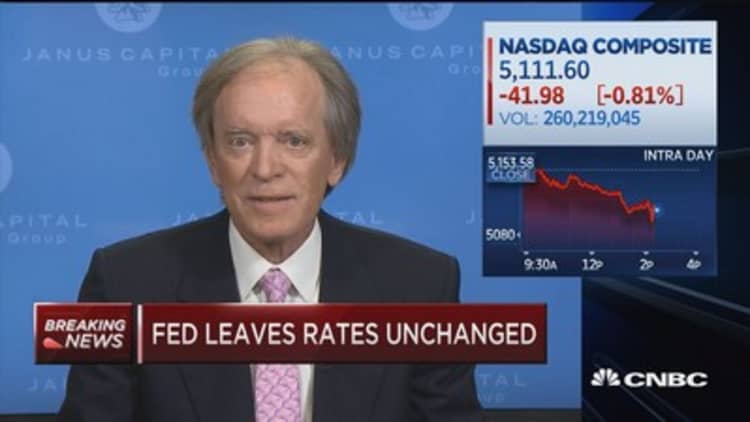Investors are in a tight spot. They're concerned about the election and a potential correction in equities. Recent market pessimism hasn't helped. The Dow Jones Industrial Average and hit four-month lows this week, and the S&P just recorded its longest consecutive days-negative stretch since 2011.
But most investors and traders seem to agree that after not raising rates on Wednesday, the Federal Reserve will keep with expectations and finally hike rates after its December meeting.
Gross domestic product data released in late October showed the U.S economy growing at 2.9 percent, higher than expected. The Fed suggested in its statement on Wednesday afternoon that the case for a rate hike was getting stronger. Rising inflation has also strengthened the case for a rate hike by the Fed.
So where does an investor put their money to combat concerns that both bond and stock prices could fall as the market inches closer to Fed action, and as the market tries to move past a rate hike and into 2017? Looking at some of the half-truths offered to investors about Fed-fighting moves can help. Here are four. These aren't investing myths, but they fall short of giving investors all the information they need to make smart decisions.
1. You don't have to bail on bonds. You just need to be more active in trading them.
The typical reaction to a Fed rate hike is to get out of bonds or only invest in ultra-short-term bonds. It's called taking as little "maturity risk" as possible. And there were some signs in October that investors were doing that, with outflows from the iShares iBoxx $ Investment Grade Corporate Bond ETF (LQD) at $1.6 billion, the biggest outflow level among all ETFs.
The biggest winners for investor flows in October among bond portfolios were short-term bond ETFs — the Vanguard Short-Term Bond ETF (BSV) and Vanguard Short-Term Corporate Bond ETF (VCSH) — as well as a Treasury inflation-protected ETF, the iShares TIPS Bond ETF (TIP).
But is it really the best way to maintain a bond position in a rising-rate environment? Another way to deal with rising rates and declining bond prices is by going with active managers. That's counterintuitive for many investors, who are told day after day that active management is dead and not worth the money.
There are a number of actively managed fixed-income ETFs that have amassed a following, such as the SPDR Double Line Total Return Tactical ETF (TOTL), managed by bond superstar Jeffrey Gundlach of DoubleLine Capital.
2. Don't expect easy volatility fixes to be a Fed panacea.
Low-volatility ETFs have been popular with investors that want to position themselves defensively while maintaining equity exposure, noted Sumit Roy, analyst at ETF.com. With election jitters and the Fed — as well as a bull market in its eighth year — now may be the time for minimum volatility strategies.
But then ask yourself why the iShares MSCI Minimum Volatility ETF (USMV) saw a very high level of outflows in October. It was in fact the single-biggest loser among U.S. equity ETFs last month, with near-$1 billion in outflows. The PowerShares S&P 500 Low Volatility ETF (SPLV) was seventh-worst among U.S. equity ETFs in October, with outflows near-$500 million.
ETF flows data is far from an exact science, but there is reason to think twice before assuming minimum-volatility strategies will be a Fed panacea.
"By holding low-volatility stocks, these ETFs have the potential to decline less in any market correction," Roy said. But — and it's a big but — "the only caveat is that some of these funds hold big weightings in sectors such as utilities and telecommunications. Those are typically safe, stable sectors, but they're also sectors that are yield-dependent. A small rise in interest rates won't have much of an impact, but if interest rates spike significantly, they could get hit."
In such a scenario, low-volatility stocks and ETFs that typically do well in uncertain markets do not look so "safe," due to their large allocation to defensive sectors. Further, a surge in their popularity earlier this year has made these ETFs expensive and vulnerable, said Neena Mishra, director of ETF research at Zacks Investment Research.

"Normally I would not recommend actively managed ETFs to investors; however, bonds are one area where active management makes some sense now," Mishra said. "After years of ultra-loose monetary policy, bonds' valuations have become stretched. Investors fear that bonds could fall sharply when the Fed starts raising rates. ... Also, there are areas in the bond market that are rather illiquid or inefficient. Active managers with specialized knowledge are in a better position to navigate tricky areas or take advantage of possible mispricings."
Unlike iShares' $42 billion Core U.S. Aggregate Bond fund (), TOTL holds fixed-income securities across the credit-quality spectrum, including high-yield bonds and emerging market bonds. Since its launch early last year, the fund has largely performed in line with AGG, but investors hope under Gundlach's guidance TOTL will eventually outperform, especially if interest rates rise and navigating the fixed-income landscape becomes more challenging.
Mishra pointed out that heavy borrowing by the government and the takeover of Fannie Mae and Freddie Mac in the aftermath of the financial crisis has left AGG with a large exposure to U.S. government and agency debt, making it more susceptible to interest rates.
Long-term data on index performance versus active managers also shows that fixed income is one of the few remaining areas where active managers can claim to put up at least a decent fight against less expensive index fund competition.
3. You don't need sophisticated hedging strategies — diversify and keep it simple.
It always makes sense to keep an eye on fees. Especially at a time when conventional wisdom would dictate that active managers have a better chance of outperforming indexes. That would mean now to many market pundits, with a bull market "long in the tooth" and more volatility expected between the election and Fed.
Mishra noted that there are now a number of ETFs that use innovative hedging strategies to address market downturns. Many of these tactically oriented managers have the ability to move in and out of cash and other defensive securities, but many charge high fees and face the usual difficulties associated with timing the market.
So it might be best to keep it simple.
"The best way to lower portfolio risk is to stay diversified," Mishra said. "An excellent way for conservative investors to stay invested in stocks is the Vanguard Total Market ETF (VTI), which charges just five basis points for fees. It's an excellent, low-risk and cheap way to gain diversified exposure to the entire universe of investable U.S. stocks. For investors who want to avoid more volatile, small-cap stocks, the iShares Core S&P 500 ETF (IVV) has the lowest expense ratio among comparable ETFs, at four basis points.
4. Forget about finding the best investments. Nothing is immune to Fed moves in this market.
This may be the simplest piece of Fed-fighting advice: Forget about the effort to find the best investment. Preservation is key.
"There is no place to hide and no place to run," said Mitch Goldberg, president of investment advisory firm ClientFirst Strategy. "If investors could understand exactly how much asset prices are tied to interest rates, they wouldn't be debating which are the best investments to make money in a rising-rate environment. It becomes a matter of preservation and taking measure of one's risk tolerance before the big, bad event."
Goldberg believes the usual rules of thumb do apply — shorten fixed-income duration, take profits on fat dividend stocks, and consider the benefits of cash (he believes it's important). "But to what extent should an investor take these rules to heart is the question we need to address," he said.
More from ETF Strategist:
Now is the time to start making next year's biggest trades
The one piece of advice millionaires are giving to families and friends about investing
How a billion-dollar investor is using ETFs
Long-term interest rates are pretty well anchored, and Goldberg sees that continuing for a long time to come. If the yield on 10-year Treasuries rose to 2 percent or 3 percent, it would not be the death knell for stocks. "But rotation out of dividend stocks after a long bull rally in those, coupled with yield products that have pushed yield seekers into them; those are the vulnerable investments," Goldberg said.
He is still hoping to pick up bargains in the highest-quality stocks. "But I can only do that if I have cash on hand and if I am willing to miss out on some upside while I wait," he said.
— By Joe D'Allegro, special to CNBC.com




